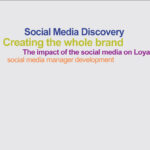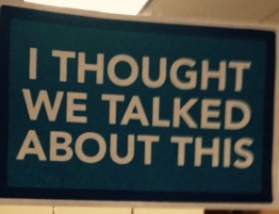Keeping Your Customers is all that Matters
January 8, 2014
Annual Fund Questionnaire
January 10, 2014Developing a Culture Built on Continuous Feedback
Changing Your Basic Approach
STEP 1
DO BEHAVIORS FOLLOW ATTITUDES or ATTITUDES FOLLOW BEHAVIORS ?
As Americans, we have developed the art of presentation – or selling. People get ideas and they learn to be successful by becoming great presenters, becoming expert in using Power Point. Just think of those two words – Power, Point – not much listening or dialog in that concept.
For 4½ years, in the 80’s’ I was the Training Director for a Regional Department Store (The Bon Marche’) and I had two major challenges: First, to change the selling culture from a clerk environment to that of a professional customer service selling culture, involving 40 stores and over 5,000 sales people. Second, I was charged with creating a greater sense of teamwork in each of the 40 operating units. Two great projects with 1980’s management concepts and technology.
We will start with the Customer Service effort. As in the 1970’s and 1980’s, there are six ways a retail store can differentiate or position itself – Price, Value, Quality, Selection, Service, or Cool. It wasn’t until Nordstrom got a major amount of press on its return policy (the story of how Nordstrom took back car tires) that the nation started paying attention to Customer Service. The book was called “The Nordstrom Way”. It was with this new awareness about the Loyalty factor of Customer Service that the retailers and eventually all organizations became engaged in adding Customer Service to the management focus.
So, there I was, given the challenge to take the local department store (located across the street from Nordstrom) into the Customer Service world.
The Bon Marche’ had been the Value department store and our company tag line was “Where the Choices Are” – which meant the company focused on Value and Selection, and now we were going to add Service. The Chairman of the company had an experience that put him on the path to change the company Service Culture. He had gotten sick while traveling to New York City – and, not having anyone with him, there he was sick and alone. He went to the hotel store to purchase some aspirin, and the young employee noticed he was sick and then took it upon herself to check in on him several times a day for the next few days. This became the Chairman’s favorite story and, during the 4 years of this Service effort, he told it whenever he could. He called this “Customer Service from the Heart” and it was the passion that drove the decision to enter the new world of Customer Service.
“Customer Service from the Heart” is about an attitude, and asking 5,000 sales people to have this attitude was a great start – but, if you know anything about retail, company policies and managers’ behaviors and focus have the major impact on someone’s attitude. So, the first thing that had to change was the company’s Return Policy. You see, to return something to The Bon Marche’ in 1983, a sales associate would have to get a department manager to sign the return credit and then the customer would have to walk to the cash office to get their $$ back. So much for customer service and good attitudes. On top of this return policy, the company had a very strong “security” attitude – which means the inventory was closely checked at least 2 times per year and departments that had excess inventory shrinkage would be given extra management oversight. Again – not good for customer service or service attitudes. So, this “protect the merchandise” and “make it hard to return” mindset was a problem for SERVICE FROM THE HEART. How could you compete with Nordstrom (who took back car tires) when our customers had to go to the cash office with two signatures to get their $$ back?
This became the birth of the “I Guarantee It” cultural change – first, every sales person now would have the power to take back the merchandise, and we changed our “clerk” title to “associate”. So, all of a sudden, we told the organization it was “Customer Service from the Heart”, you are now an Associate, and each of you has the power to deal with your customers without a management signature. Wow! What a shift – and, for the first 9 months no one believed it was true. There were still inventories and security and, while a few wanted to believe, there was this wait-and-see approach – “I don’t want to be the first to screw up”.
As we messaged, trained and met with teams of employees, we also decided that we needed a Mystery Shopper Program which we called “The Hanger Report”. It was an opportunity to design a survey and then pay a “professional” shopper to come into each of our stores and give a rating for that shopping experience. Although mystery shoppers are still used today, this started as a total disaster. Stores would get between 4 and 12 shops per month and, although the shops were random, the ratings would always include the date, time of day and department shopped. So, when the scores came out, it was obvious to store management which sales associates had received the bad scores – and then of course the department manager used this to tell those associates about the score. Now the entire store looked at these shops as just another typical management hammer – we didn’t trust them – we just found another way to pressure and make the associate’s job more difficult. So, here we were trying to drive “Customer Service from the Heart”, and our mystery shoppers were showing our associates that we had no heart, we just had mystery shoppers.
Well, one morning I got an idea that turned out to be one of the lessons that I still use today – and is the most important foundational element of any cultural change. Management needs to transfer the ownership of the change to the employees – until they own it, it is just another “best practice” (or, as we used to say, a bohica – or “bend over, here it comes again”).
The idea was to have all 5,000 employees take our Mystery Shop Survey and go shop a store of their choice, and then rate that store’s service on our standard. I had thought that the real problem with our effort was the fact that the associates really did not know our standards or expected behaviors. Instead of more training classes, have them experience the shop from the customer’s point of view. You can imagine the reaction I got when I presented this idea to my boss (the Senior Vice President of Human Resources). But, to my amazement, a week later he said it was approved. We would give all employees one hour of time to go shop a competitor. Everyone in all parts of the Company (from sales associates, to the distribution center, to the corporate offices) was given one hour to shop a competitor, then hold a meeting to discuss their experience and report to their boss – so on and so on, all the way to the Chairman.
The results of this all-company activity were incredible. Not only did every employee gain an understanding of our service/behavior standards, almost like magic the Company got PRIDE. You see, they found out that we were better than most other retailers – and, in fact, if you went to Nordstrom and were not “dressed right”, you got ignored. Nordstrom people are on commission, so “look right” and you get lots of attention, “look wrong” and you get ignored. The attitude changed when the entire Company understood the “behaviors” of our customer service expectation, and decided to not only own those standards but believe we were better than the competitors.
There was also another lesson that now is even more important – as the front-line employees held the meetings to discuss their experience, the managers were put in a place to listen, and the associates, in many cases, were given their first opportunity to give input about how to improve the service. What a concept – our management team listening to the employees and receiving quality input on how to make things better.
Four great learning’s came from this experience:
- Cultures don’t change until the people in the culture own the change;
- It’s all about behaviors;
- Pride is required to have passion;
- If you want to get better, management needs to listen.
So, we spend a lot of time figuring out how to change cultures and improve attitudes. How do we compete in this new world? When it is all said and done, these four learning’s may say it all.
Changing your basic approach
Step 2
IS IT ALL ABOUT THE LEADER or ALL ABOUT THE TEAM
The Softer Side of Management Training
Throughout my entire career, I have always been interested in the role of management in creating and sustaining organizational cultures. As is always stated, the culture of an organization begins at the top and its impact on the entire organization is substantial. What the senior leader pays attention to, the questions they ask regularly, whether they are seen outside of their “power place”, do they seem to like people, who gets promoted, and do they seem to know what they are talking about – all have a huge impact on how the organizational culture develops.
At the time I was given the challenge to change the Customer Service Culture of The Bon Marche’, I was also to improve our Management Training Program – especially focus on our stores organization. Again, this was the middle 1980’s and the hot books were all about the softer side of management – people skills. Management is always about getting/delivering numbers – top line sales, margins, efficiency, and all of these focused on delivering bottom line profit.
In the 1980’s, we were still in a period where, although quarterly reports were important, America still focused more on the annual performance. So, there I was, looking at a 40-store department store chain with a highly developed “operations culture”, trying to bring on a Customer Service enhanced culture, with Store Managers who were not always the warmest/kindest people in the world. The culture that got them promoted was quantitative results. The Company would always do its planning by establishing the profit margin it wanted, projecting the top line sales, and then put all of the operating expenses into the middle. In other words, since store labor was the largest expense category, the company’s business operating strategies always added up with the final decisions being made around the expense associated to people – the # of people, production per hour, full-time vs. part-time – all of those business decisions that create human resource issues. Department stores were open in those days 7 days a week up to 12 hours per day, and this always meant lots of people with lots of personal issues.
There, in the middle of the 1980’s, we were changing cultures – adding Customer Service, improving attitudes, improving profits, and trying to change how management worked together.






2 Comments
Admiring the time and effort you put into your site and in depth information you present. It’s good to come across a blog every once in a while that isn’t the same unwanted rehashed information. Excellent read! I’ve saved your site and I’m adding your RSS feeds to my Google account.